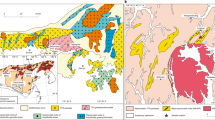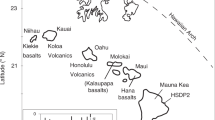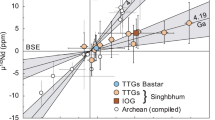Abstract
Partial melting of the Earth’s mantle is a key process in the generation of crustal material and the formation of continents1. Crustal samples record the generation of crust up to 4.4 billion years (Gyr) ago2,3,4,5,6,7,8,9, yet the complementary record in the mantle extends to only 3.3 Gyr ago1, with sparse evidence for differentiation occurring 3.9–4.1 Gyr ago10,11. Here we use the Pt–Os isotope chronometer to show that a Hadean record of mantle depletion is preserved in Earth’s oldest known ultramafic rocks, the Ujaragssuit Nunât intrusion of southwest Greenland. We identify two distinct age populations at approximately 4.1 and 2.9 Gyr. We suggest that the younger age population records a regional metamorphic event and the older one records mantle depletion. We also identify individual sample ages of up to 4.36 Gyr old, thus extending the record of large mantle-melting events into the Hadean. Furthermore, the preservation of Hadean model ages in Os-rich mantle-derived rocks supports the theory that re-enrichment of Os in the mantle during the Late Heavy Bombardment—after expected partitioning into the Earth’s core—occurred at least 0.2 Gyr earlier than previously thought. This also implies that the Earth could have been habitable by 4.1 Gyr ago.
This is a preview of subscription content, access via your institution
Access options
Subscribe to this journal
Receive 12 print issues and online access
$259.00 per year
only $21.58 per issue
Buy this article
- Purchase on Springer Link
- Instant access to full article PDF
Prices may be subject to local taxes which are calculated during checkout


Similar content being viewed by others
Change history
21 August 2013
In the version of this Letter originally published, 'chromitite' was misspelled in the title. This has been corrected in all versions of the Letter.
References
Pearson, D. G., Parman, S. W. & Nowell, G. M. A link between large mantle melting events and continent growth seen in osmium isotopes. Nature 449, 202–205 (2007).
Boyet, M. & Carlson, R. W. A new geochemical model for the Earth’s mantle inferred from 146Sm–142Nd systematics. EPSL 250, 254–268 (2006).
Bennett, V. C., Brandon, A. D. & Nutman, A. P. Coupled 142Nd–143Nd isotopic evidence for Hadean mantle dynamics. Science 318, 1907–1910 (2007).
Rizo, H. et al. The elusive Hadean enriched reservoir revealed by 142Nd deficits in Isua Archean rocks. Nature 491, 96–99 (2012).
O’Neil, J., Carlson, R. W., Paquette, J-L. & Francis, D. Formation age and metamorphic history of the Nuvvuagittuq Greenstone Belt. Precambr. Res. 220–221, 23–44 (2012).
Condie, K. C., Belousova, E., Griffin, W. L. & Sircombe, K. N. Granitoid events in space and time: Constraints from igneous and detrital zircon age spectra. Gondwana Res. 15, 228–242 (2009).
Wilde, S. A., Valley, J. W., Peck, W. H. & Graham, C. M. Evidence from detrital zircons for the existence of continental crust and oceans on the Earth 4.4 Gyr ago. Nature 409, 175–178 (2001).
Harrison, T. M. et al. Heterogeneous hadean hafnium: Evidence of continental crust at 4.4 to 4.5 Ga. Science 310, 1947–1950 (2005).
Dhuime, B., Hawkesworth, C. J., Cawood, P. A. & Storey, C. D. A change in the geodynamics of continental growth 3 billion years ago. Science 335, 1334–1336 (2012).
Aulbach, S. et al. Mantle formation and evolution, Slave Craton: constraints from HSE abundances and Re–Os isotope systematics of sulfide inclusions in mantle xenocrysts. Chem. Geol. 208, 61–88 (2004).
Malitch, K. N. & Merkle, R. K. W. Ru–Os–Ir–Pt and Pt–Fe alloys from the Evander Goldfield, Witwatersrand Basin, South Africa: Detrital origin inferred from compositional and osmium-isotope data. Can. Mineral. 42, 631–650 (2004).
Wittig, N. et al. Formation of the North Atlantic Craton: Timing and mechanisms constrained from Re–Os isotope and PGE data of peridotite xenoliths from S.W. Greenland. Chem. Geol. 276, 166–187 (2010).
Rollinson, H., Appel, P. W. U. & Frei, R. A metamorphosed, early Archean chromitite from West Greenland: Implications for the genesis of Archean anorthositic chromitites. J. Petrol. 43, 2143–2170 (2002).
Pagé, P., Barnes, S-J., Bédard, J. H. & Zientek, M. L. In situ determination of Os, Ir, and Ru in chromites formed from komatiite, tholeiite and boninite magmas: Implications for chromite control of Os, Ir and Ru during partial melting and crystal fractionation. Chem. Geol. 302-303, 3–15 (2012).
Anders, E. & Grevesse, N. Abundances of the elements: Meteoritic and solar. Geochim. Cosmochim. Acta 53, 197–214 (1989).
Begemann, F. et al. Call for an improved set of decay constants for geochronological use. Geochim. Cosmochim. Acta 65, 111–121 (2001).
Luguet, A., Shirey, S. B., Lorand, J-P., Horan, M. F. & Carlson, R. W. Residual platinum-group minerals from highly depleted harzburgites of the Lherz massif (France) and their role in HSE fractionation of the mantle. Geochim. Cosmochim. Acta 71, 3082–3097 (2007).
Coggon, J. A. et al. The 190Pt–186Os decay system applied to dating platinum-group element mineralization of the Bushveld Complex, South Africa. Chem. Geol. 302–303, 48–60 (2012).
Pretorius, W., Chipley, D., Kyser, K. & Helmstaedt, H. Direct determination of trace levels of Os, Ir, Ru, Pt and Re in kimberlite and other geological materials using HR-ICP-MS. J. Anal. At. Spectrom. 18, 302–309 (2003).
Carlson, R. W. Application of the Pt–Re–Os isotopic systems to mantle geochemistry and geochronology. Lithos 82, 249–272 (2005).
Rudnick, R. L. & Walker, R. J. Interpreting ages from Re–Os isotopes in peridotites. Lithos 112S, 1083–1095 (2009).
Brandon, A., Walker, R. J. & Puchtel, I. S. Platinum–osmium isotope evolution of the Earth’s mantle: Constraints from chondrites and Os-rich alloys. Geochim. Cosmochim. Acta 70, 2093–2103 (2006).
Bennett, V. C., Nutman, A. P. & Esat, T. M. Constraints on mantle evolution from 187Os/188Os isotopic compositions of Archean ultramafic rocks from southern West Greenland (3.8 Ga) and Western Australia (3.46 Ga). Geochim. Cosmochim. Acta 66, 2615–2630 (2002).
Fortenfant, S. S. et al. Oxygen fugacity dependence of Os solubility in haplobasaltic melt. Geochim. Cosmochim. Acta 70, 742–756 (2006).
Mann, U., Frost, D. J., Rubie, D. C., Becker, H., A. & Audétat, Partitioning of Ru, Rh, Pd, Re, Ir and Pt between liquid metal and silicate at high pressures and high temperatures—Implications for the origin of highly siderophile element concentrations in the Earth’s mantle. Geochim. Cosmochim. Acta 84, 593–613 (2012).
Newsom, H. E. in Global Earth Physics: A Handbook of Physical Constants: AGU Reference Shelf (ed. Ahrens, T. J.) 159–89 (American Geophysical Union, 1995).
Kimura, K., Lewis, R. S. & Anders, E. Distribution of gold and rhenium between nickel-iron and silicate melts: Implications for the abundance of siderophile elements on the Earth and Moon. Geochim. Cosmochim. Acta 38, 683–701 (1974).
Morbidelli, A., Marchi, S., Bottke, W. F. & Kring, D. A. A sawtooth-like timeline for the first billion years of lunar bombardment. Earth Planet. Sci. Lett. 355–356, 144–151 (2012).
Day, J. M. D., Walker, R. J., Qin, L. & Rumble, D. Late accretion as a natural consequence of planetary growth. Nature Geosci. 5, 614–617 (2012).
Luguet, A., Nowell, G. M. & Pearson, D. G. 184Os/188Os and 186Os/188Os measurements by Negative Thermal Ionisation Mass Spectrometry (N-TIMS): Effects of interfering element and mass fractionation corrections of data accuracy and precision. Chem. Geol. 248, 342–362 (2008).
Acknowledgements
R. Carlson and C. Hawkesworth are thanked for providing reviews. A.L. thanks the European Research Council for financially supporting this research project (ERC research grant 258558 ‘Early Earth’).
Author information
Authors and Affiliations
Contributions
A.L. conceived the project. J.A.C. carried out HSE and Os isotope analyses and A.L. and J.A.C. wrote the paper. P.W.U.A. collected samples, provided detailed information of geological setting and background, carried out initial petrography and sample selection. G.M.N. provided analytical support during isotopic analyses and assisted with model age calculations. All authors contributed to the discussion of the results and commented on the manuscript.
Corresponding author
Ethics declarations
Competing interests
The authors declare no competing financial interests.
Supplementary information
Supplementary Information
Supplementary Information (PDF 1107 kb)
Supplementary Information
Supplementary Information (XLS 45 kb)
Rights and permissions
About this article
Cite this article
Coggon, J., Luguet, A., Nowell, G. et al. Hadean mantle melting recorded by southwest Greenland chromitite 186Os signatures. Nature Geosci 6, 871–874 (2013). https://doi.org/10.1038/ngeo1911
Received:
Accepted:
Published:
Issue Date:
DOI: https://doi.org/10.1038/ngeo1911
This article is cited by
-
Ruthenium isotope vestige of Earth’s pre-late-veneer mantle preserved in Archaean rocks
Nature (2020)
-
Effects of multi-stage rifting and metasomatism on HSE-187Os/188Os systematics of the cratonic mantle beneath SW Greenland
Contributions to Mineralogy and Petrology (2019)
-
Implications for the origins of Eoarchean ultramafic rocks of the North Atlantic Craton: a study of the Tussaap Ultramafic complex, Itsaq Gneiss complex, southern West Greenland
Contributions to Mineralogy and Petrology (2019)
-
Pt-Os isotopic constraints on the age of hydrothermal overprinting on the Jinchuan Ni-Cu-PGE deposit, China
Mineralium Deposita (2018)
-
Electrical conductivity of hydrous silicate melts and aqueous fluids: Measurement and applications
Science China Earth Sciences (2016)



